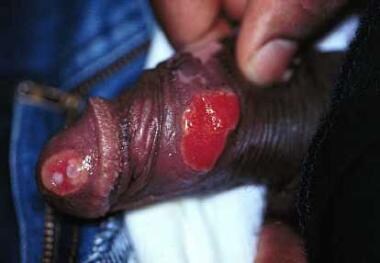Background
Granuloma inguinale is a chronic bacterial infection that frequently is associated with other sexually transmitted diseases. Granuloma inguinale is characterized by intracellular inclusions in macrophages referred to as Donovan bodies. Granuloma inguinale usually affects the skin and mucous membranes in the genital region, where it results in nodular lesions that evolve into ulcers. The ulcers progressively expand and are locally destructive, as demonstrated in the image below.
Pathophysiology
The intracellular organism responsible for granuloma inguinale was initially described by Donovan over a century ago, and subsequently, the bacterium was classified in 1913 as Calymmatobacterium granulomatis. Although Anderson suggested that the organism be eponymously named Donovania granulomatosis, Carter et al discovered that the molecular structure of the causative organism was similar to Klebsiella species and reclassified the gram-negative pleomorphic bacillus as Klebsiella granulomatis. [1, 2]
The mode of transmission of granuloma inguinale primarily occurs through sexual contact; however, it is hypothesized to have low infectious capabilities because repeated exposure is necessary for clinical infection to occur. Additionally, granuloma inguinale may also be obtained through the fecal route or by passage through an infected birth canal.
Etiology
Granuloma inguinale is caused by Klebsiella granulomatis, a gram-negative pleomorphic bacillus formerly known as Calymmatobacterium granulomatis.
Epidemiology
Frequency
United States
Fewer than 100 cases of granuloma inguinale are reported annually, many of which are thought to be acquired during foreign travel.
International
Granuloma inguinale is rare in temperate climates, but it is common in the tropics and subtropics. Granuloma inguinale is endemic in Western New Guinea, the Caribbean, Southern India, South Africa, Southeast Asia, Australia, and Brazil. [3] However, results from a 2020 study suggested that K granulomatis is no longer a prevalent cause of genital ulcer disease in the South African population. [4]
Race
The incidence is higher in blacks than in whites in the United States. The incidence is higher in native persons than in Europeans in Western New Guinea. The incidence is higher in Hindus than in Muslims in India. These differences are more likely the result of disparities in socioeconomic status and living conditions than of a racial susceptibility. [5]
Sex
No sexual predominance is reported for granuloma inguinale.
Age
Granuloma inguinale most commonly is seen in sexually active people aged 20-40 years.
Prognosis
Relapse may occur up to 18 months after treatment. If untreated, the lesions may continue to expand for years. If granuloma inguinale remains untreated, secondary infections and lymphedema/elephantiasis may occur. Persistent granuloma inguinale lesions continue to expand and are locally destructive. Treated granuloma inguinale lesions tend to exhibit extensive fibrosis, resulting in strictures. Squamous cell carcinoma and less often basal cell carcinoma can develop in long-standing lesions and/or scars. Also see Complications.
Patient Education
For patient education resources, visit the Sexual Health Center. Additionally, see the patient education article Sexually Transmitted Diseases (STDs).
-
Beefy-red penile ulcers.
-
Courtesy of Hon Pak, MD.
-
Courtesy of Hon Pak, MD.
-
Courtesy of Hon Pak, MD.










